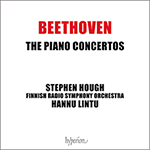
Welcome to Hyperion Records, a British classical label devoted to presenting high-quality recordings of music of all styles and from all periods from the twelfth century to the twenty-first.
Hyperion offers both CDs, and downloads in a number of formats. The site is also available in several languages.
Please use the dropdown buttons to set your preferred options, or use the checkbox to accept the defaults.

| Sir Stephen Hough (piano), Finnish Radio Symphony Orchestra, Hannu Lintu (conductor)» More |
The key of C minor was frequently used by Beethoven—notably in his fifth symphony—and the stormy moods associated with this key are frequently in evidence here, alongside gentler passages such as the beautiful second theme and the profoundly tender adagio, written in the remote key of E major. The cadenza that Beethoven wrote for Archduke Rudolph in 1809 is admirably fitted to the rest of the first movement, incorporating the stormy first theme and the lyrical second theme, along with some dazzling piano figuration. The concerto is often compared with Mozart’s C minor piano concerto (K491), and both begin with a portentous unison passage. But when Beethoven conceived and composed the work, Mozart’s was hardly known, since it was not published until 1800. Thus there is little, if any, direct influence from Mozart’s work, although the similarities show how thoroughly Beethoven had absorbed Mozart’s style.
The finale, once again in rondo form, is back in C minor, but it unexpectedly veers into E major towards the end, recalling the slow movement in a surprisingly tender passage. The nervy character of the C minor theme returns, but after a short cadenza the music bursts into a joyful C major (as does the end of the fifth symphony), with the theme transformed into a lively dance, as the pessimism heard earlier gives way to an exuberant and optimistic ending.
from notes by Barry Cooper © 2020
Beethoven utilisait souvent la tonalité d’ut mineur—notamment dans sa cinquième symphonie—et les atmosphères orageuses liées à cette tonalité sont ici souvent manifestes, à côté de passages plus doux comme le magnifique second thème et l’adagio profondément tendre, écrit dans la tonalité éloignée de mi majeur. La cadence que Beethoven composa pour l’archiduc Rodolphe en 1809 se prête parfaitement au reste du premier mouvement, incluant le premier thème orageux et le second thème lyrique, avec une figuration éblouissante au piano. Ce concerto est souvent comparé au Concerto pour piano en ut mineur (K491) de Mozart, et les deux commencent par un passage grave à l’unisson. Mais lorsque Beethoven conçut et composa cette œuvre, celui de Mozart était à peine connu, puisqu’il ne fut publié qu’en 1800. Il y a donc peu d’influence directe de l’œuvre de Mozart, même si les similitudes montrent à quel point Beethoven avait assimilé le style de Mozart.
Le finale, une fois encore en forme rondo, revient à la tonalité d’ut mineur, mais il passe, de façon inattendue, en mi majeur à la fin, rappelant le mouvement lent dans un passage d’une tendresse surprenante. Le caractère nerveux du thème en ut mineur revient, mais, après une courte cadence, la musique s’engouffre dans un joyeux ut majeur (comme la fin de la cinquième symphonie), avec le thème transformé en une danse pleine d’entrain, lorsque le pessimisme précédent fait place à une conclusion exubérante et optimiste.
extrait des notes rédigées par Barry Cooper © 2020
Français: Marie-Stella Pâris
Die Tonart c-Moll verwandte Beethoven gern—sein bekanntestes c-Moll-Werk ist seine fünfte Sinfonie—und häufig trifft man hier die damit assoziierte stürmische Stimmung an, freilich neben sanfteren Passagen wie dem herrlichen zweiten Thema und dem zutiefst zärtlichen Adagio, im weit entfernten E-Dur geschrieben. Die 1809 für Erzherzog Rudolph komponierte Kadenz passt bewundernswert in den ersten Satz; sie greift das stürmische erste ebenso wie das lyrische zweite Thema auf und kombiniert sie mit hochvirtuos-pianistischen Figurationen. Oft wird das Konzert mit Mozarts c-Moll-Konzert KV 491 verglichen; schließlich beginnen beide mit einem gewichtigen Unisono. Als Beethoven jedoch sein Werk entwarf und ausarbeitete, war das Mozarts kaum bekannt; es wurde erst 1800 veröffentlicht. So müssen wir davon ausgehen, dass Mozarts Konzert das Beethovens kaum, wenn überhaupt, beeinflusste, auch wenn die Parallelen zeigen, wie tief Beethoven den Stil Mozarts verinnerlicht hatte.
Das Finale, abermals ein Rondo, kehrt nach c-Moll zurück, weicht jedoch gegen Ende unerwartet nach E-Dur aus und ruft den langsamen Satz in einer überraschend zarten Passage in Erinnerung. Der unruhige Charakter des c-Moll-Themas kehrt wieder. Doch nach einer kurzen Kadenz bricht die Musik in ein freudiges C-Dur aus (ganz wie am Ende der Fünften), in dem sich das Thema in einen lebhaften Tanz verwandelt. Der zuvor pessimistische Ton weicht einem Schluss voller Überschwang und Zuversicht.
aus dem Begleittext von Barry Cooper © 2020
Deutsch: Friedrich Sprondel
 Beethoven: The Piano Concertos Beethoven: The Piano ConcertosHearing Stephen Hough over the course of one of music’s greatest odysseys is an opportunity not to be missed. Recorded following a cycle of live performances, this magnificent set is sure to be recognized as one of Hough’s most important recording ...» More |

